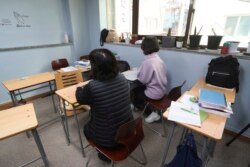South Korea does not consider children who are half North Korean and half Chinese as refugees. But these young people face many problems that refugees from North Korea do. They have a difficult time integrating into South Korean society.
To tell their stories, The Associated Press recently talked to some of the children, their North Korean mothers, teachers, experts, and government officials.
In the 1990s, thousands of North Korean women fled their homeland. They went to China in search of food and work. Many women were sold to Chinese farmers as brides, before fleeing again and moving to South Korea.
Many of the women's children are now reaching adulthood.
One woman’s story
One example is 19-year-old Song Hong Ryon. She looks like any other young woman in South Korea. But three years after her arrival from China, she has made only two South Korean-born friends.
Song says she has often been hurt by little things, like when people ask if she is from China. “I’ve agonized about it a lot by myself,” she said.
Many of the North Korean mothers lived in China in fear of being captured and sent back to the North. When they made the trip to South Korea, they often left their children in China.
The lucky ones, after getting jobs and saving money in South Korea, helped their children and husbands travel to the country. But some children were left behind or their fathers refused to leave their hometowns.
Family reunions, if they happen at all, often take years.
Many of the children of these marriages, if they are unable to reunite with their mothers in the South, get upset as they struggle to live in a strange culture. They are often cut off from friends and many of their family members.
Song said she was 10 years old when her mother left their home in northeastern China in 2010. A year later, her father also went to South Korea, leaving her with her grandparents.
“When my mom left, I didn’t cry. But when my dad left, I cried a lot,” Song said. “I think it was because I felt I was truly alone then.”
She only reunited with her parents in 2016 in South Korea after a six-year separation. Last December, her mother died of lung cancer.
On arriving in South Korea, the children get citizenship because their mothers are now South Korean nationals. But because they do not have a direct link to North Korea, they cannot legally receive some other help that North Korean-born refugees get.
Special aid for North Koreans
Those missed benefits include the right to bypass the national university entrance exam, a college tuition waiver and, for men, a choice about whether to perform two years of required military service.
South Koreans are often not sure whether the children are Chinese, South Korean or North Korean refugees. Because neither parent was born in the South, they do not have someone to help join the country's society.
South Korea’s Education Ministry reports that about 1,550 such children were enrolled in primary, middle and high schools across the country as of April this year. The true number is likely higher.
In comparison, there were about 980 North Korean-born students.
In recent years, the government has tried to help by providing $3,390 to their families. It has also sent more foreign language teachers to schools. In May, an opposition lawmaker proposed giving China-born North Korean children the same assistance given to North Korean-born refugees.
Shim Yang-sup, head of the Seoul-based South-North Love School, said the children should be supported because they have an important resource: the ability to speak two languages.
Kim Hyun-seung, from Tianjin, China, arrived in South Korea three years ago to reunite with his mother, who came six years earlier. Kim’s 52-year-old mother, Kim So-yeon, described him as “a great, loyal son.”
Tall and thin, Kim said he would not object to serving in the South Korean military and dreams of working as a chef in a French restaurant.
But he does not want a serious girlfriend out of fear they would “become a couple like my father and mother that gives pain to their child, fails to live together and worries about many things.”
I'm Mario Ritter.
And I'm Dorothy Gundy.
Hyung-Jin Kim reported on this story for the Associated Press. John Russell adapted it for VOA Learning English. George Grow was the editor.
__________________________________________________________
Words in This Story
integrate – v. to make (a person or group) part of a larger group or organization
bride – n. a woman on the day when she is to be married
agonize – v. to think or worry very much about something
upset – adj. unhappy
benefit – v. to receive a profit or gain
bypass – v. to go around or avoid (a place or area)
waiver – n. an official document indicating that someone has given










